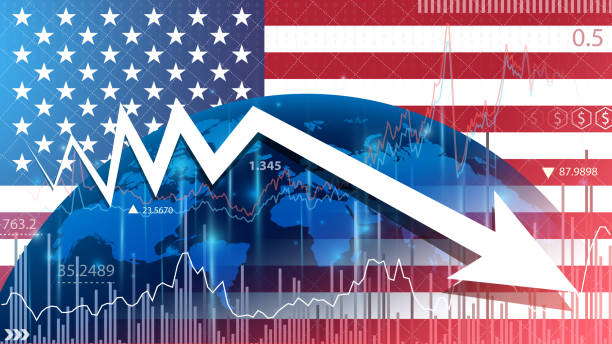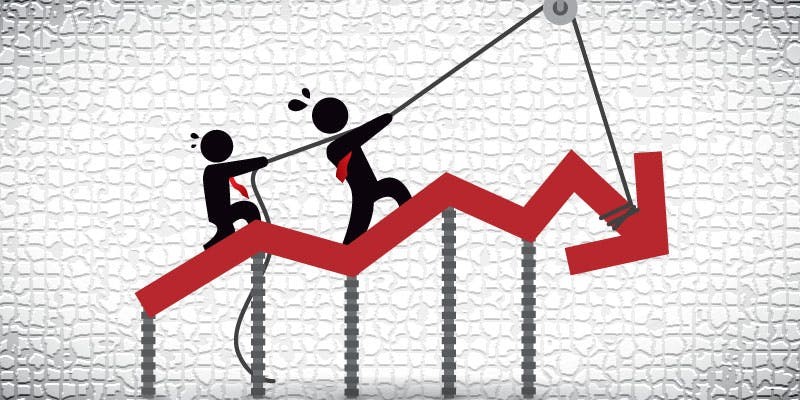Japan and the UK have both entered recessions, marking a negative in two of the world’s largest economies, and the question now doing the rounds is, could the United States be the next to follow?
As Japan and the UK reported negative gross domestic product (GDP) for the second consecutive quarter, thus meeting the commonly accepted criteria for a recession, the possibility of the United States, the largest economy globally, facing a similar fate seems possible.
The Facts And Figures
Paul Donovan, the chief economist at UBS Global Wealth Management, noted on Thursday that Japan’s economic downturn is intricately linked to its declining population.
Over the course of 2022, Japan’s population shrank by 800,000 individuals, marking the 14th consecutive year of contraction; this demographic trend is constraining the country’s growth potential, as fewer people result in reduced production and consumption levels, as highlighted by Donovan.
When it comes to the UK, the economic decline occurred despite population and wage growth. However, it was still insufficient to prevent a decline in consumer spending, a crucial driver of its economy.
The situation in the United States stands in sharp contrast.
Over the last two quarters, the country’s economy witnessed significantly higher-than-expected GDP growth, primarily attributed to good consumer spending.
Another point to be noted is that the US economy holds a competitive advantage over most advanced economies, primarily due to the infusion of $5 trillion in pandemic stimulus funds.
These stimulus funds continue to support household finances; moreover, the US is less reliant on Russian energy, reducing its vulnerability to the surge in natural gas prices following the full-scale invasion of Ukraine in February 2022.
However, January’s recent US retail sales data fell below expectations, indicating a possible tightening of consumer spending after a record-breaking holiday season.
Nevertheless, the labour market in the US remains robust, as evidenced by the unemployment rate consistently staying below 4% for the past 24 months.
Considering all the positives mentioned above, there is still the likelihood that the United States will be on the brink of a recession in 2024, unbeknownst to many Americans.

The determination of whether the economy is in recession isn’t immediate or widespread; instead, it falls upon a relatively obscure group of eight economists.
This group, known as the Business Cycle Dating Committee at the National Bureau of Economic Research, identifies a recession retrospectively, based on criteria such as a significant and sustained decline in economic activity across various sectors over a period of several months.
Factors like a sharp rise in unemployment, declining incomes, substantial drops in spending, or negative economic growth rates are among those considered, though there’s no rigid formula.
However, it’s worth noting that two consecutive quarters of negative GDP growth do not automatically constitute a recession – this scenario played itself out in the US in 2022 without the NBER committee declaring a recession.
Despite the tightening cycle initiated by the US Federal Reserve in March 2022, Federal Reserve Chair Jerome Powell stated in December that the likelihood of the economy being in a recession presently is slim.
Nevertheless, Powell cautioned that even during periods of apparent economic prosperity, the possibility of a recession within the coming year remains ever-present due to unforeseen shocks such as a global pandemic.
Philipp Carlsson-Szlezak, the global chief economist at the Boston Consulting Group, holds the view that the US is unlikely to slip into a recession this year, and instead, he anticipates a year of sluggish growth.
Carlsson-Szlezak attributes the resilience of the US economy to its foundational strengths, particularly the robustness of the labour market and the financial stability of American households.
Although Carlsson-Szlezak acknowledges the possibility, he believes one potential route to a US recession in 2024 could emerge if the Federal Reserve refrains from cutting interest rates throughout the year.
Given the widespread anticipation of multiple rate cuts in 2024 among investors, the failure of such expectations to materialize could inflict significant harm on financial markets, potentially triggering a recession, according to Carlsson-Szlezak.
/cdn.vox-cdn.com/uploads/chorus_asset/file/23463629/1238448862.jpg)
Apart from the small economic positives, there is one more aspect that needs to be considered.
As per insights from a former senior Pentagon official and equity analyst tracking Olin, the United States government generates approximately $30 million annually from arms and ammunition sales.
In 2022, direct military sales by US companies surged by 48.6%, reaching $153.7 billion, compared to $103 billion in 2021.
At the same time, sales facilitated through the US government also saw a notable uptick, rising by 49.1% to $51.9 billion in 2022 from $34.8 billion the previous year.
In 2022, the top five weapons contractors in the United States collectively garnered $196 billion in revenue related to military activities. Among these contractors, Lockheed Martin emerged as the dominant player, boasting a total military revenue of approximately $63 billion in the preceding year.
Hence, clearly the United States holds the title of the world’s largest arms dealer – over the span of 2017 to 2021, it supplied weapons to more than 100 nations.
Notably, in 2020 alone, American defence companies amassed a staggering $111 billion from foreign military sales.
Now let us look at the timeline of Recent Recessions Faced by the US and understand what we are pointing towards!
1. The Dot-Bomb Recession: March 2001–November 2001
-
- Duration: Eight months
- GDP decline: 0.3%
- Peak unemployment rate: 5.5%
Reasons and Causes –
The dot-com bubble’s collapse contributed to one of the mildest recessions on record, following the longest economic expansion in US history.
The Federal Reserve raised the fed funds rate from 4.75% in early 1999 to 6.5% by July 2000. The September 11 attacks and the associated economic disruptions may have hastened the recession’s end by encouraging the Fed to keep cutting the fed funds rate. The benchmark rate reached a low of 1% by mid-2003.
2. The Great Recession: December 2007–June 2009
-
- Duration: Eighteen months
- GDP decline: 4.3%
- Peak unemployment rate: 9.5%
Reasons and Causes –
The nationwide downturn in US housing prices triggered a global financial crisis, a bear market in stocks that had the S&P 500 down 57% at the lows, and the worst economic downturn since the recession of 1937-38.
Global investment flows into the US had kept market rates low, likely encouraging unscrupulous mortgage underwriting and mortgage-backed securities marketing practices.
Oil prices spiked to record highs by mid-2008 and then crashed, depressing the US oil industry. Dropping oil and commodity prices led to deflation and strained the US economy.
3. The COVID-19 Recession: February 2020–April 2020
-
- Duration: Two months
Reasons and Causes –
The COVID-19 pandemic spread to the US in March 2020, and the resulting travel and work restrictions caused employment to plummet, triggering an unusually short recession.
The unemployment rate climbed from 3.5% in February 2020 to 14.7% in April 2020 but was back below 4% by the end of 2021, capped by $5 trillion in pandemic relief spending.
In addition, quantitative easing by the Federal Reserve expanded its balance sheet from $4.1 trillion in February 2020 to nearly $9 trillion by the end of 2021, complementing a federal funds rate that remained near zero until March 2022.

The Viewpoint -Times When The US Has Slipped Into Recession And Has Launched Military Operations –
The convergence of US military engagements with periods of economic recession raises intriguing considerations regarding the intertwined relationship between warfare, economic activity, and the arms industry.
The coinciding timelines of US recessions and military interventions, such as the invasions of Afghanistan and Iraq, promote analysis of how these events may have impacted the economy, particularly in the sales of US companies dealing in arms and ammunition.
For example, in the aftermath of the September 11, 2001, terrorist attacks, the United States launched military operations in Afghanistan with the aim of dismantling Al-Qaeda and ousting the Taliban regime; simultaneously, the nation was grappling with the aftermath of the Dot-Bomb Recession, which commenced in March 2001.
The subsequent surge in defence spending to support military operations likely injected significant funds into the economy, providing a boost during a period of economic downturn.
Similarly, the invasion of Iraq under Operation Iraqi Freedom, initiated in 2003 and follows, still coincided with economic challenges, including the lingering effects of the Dot-Bomb Recession and the Great Recession that followed in 2007-2009.
The massive influx of defense contracts and expenditures associated with military campaigns likely provided a stimulus to sectors involved in arms manufacturing and related industries.
This infusion of government spending could have served as a stabilizing force within the economy, potentially mitigating the impact of recessionary pressures.
Similarly, the sustained nature of military engagements, such as Operation Inherent Resolve against ISIL, spanning over extended periods, could have provided a steady revenue stream for defence contractors and suppliers.
The consistent demand for weaponry, equipment, and logistical support to sustain military operations overseas likely contributed to the resilience of the arms industry, even amidst economic downturns.
Hence, in light of the ongoing global upheaval and with each country forming possible allies in the eye of the storm, could the United States launch yet another extensive military operation in a bid to bolster its economy, as has already been seen in the case of ongoing Red Sea developments?




